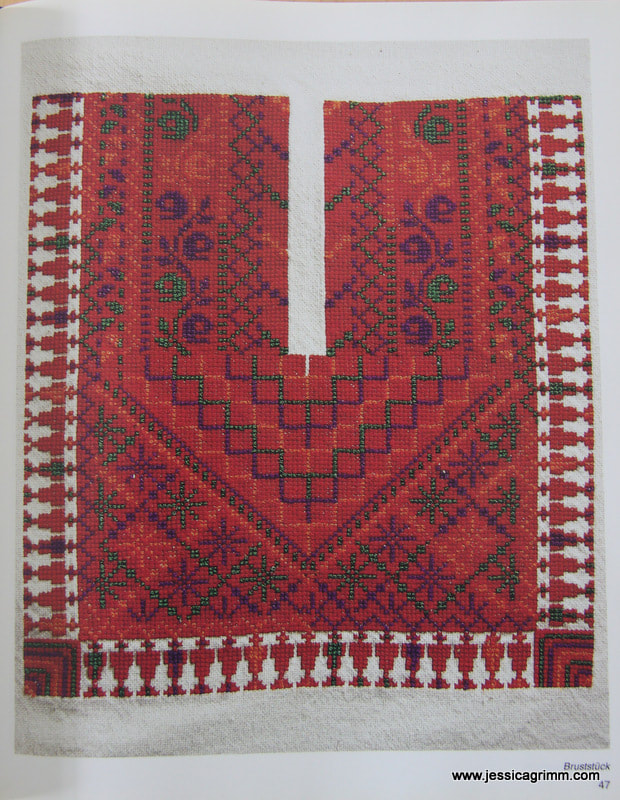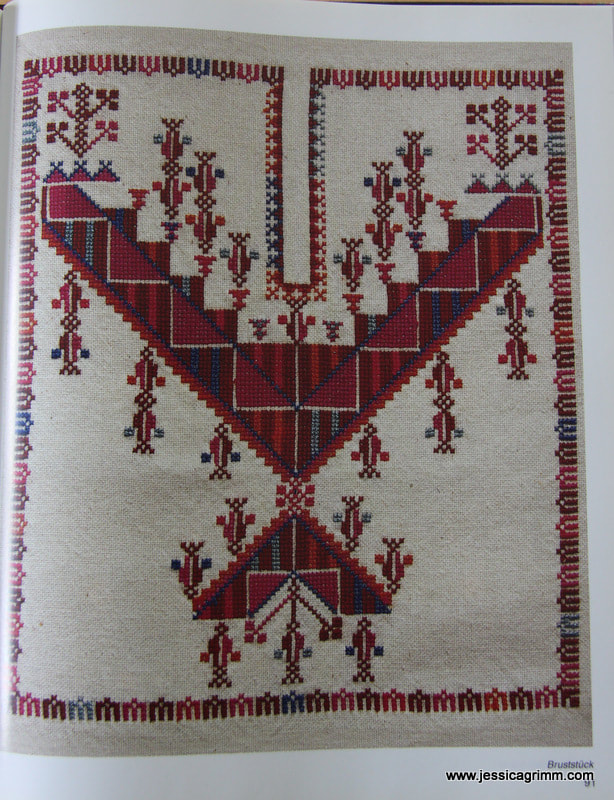|
I turned 40 recently. And as it goes: birthdays and presents go hand in hand. So when I visited Munich with my parents, we found an unusual embroidery book for my library. Before I'll show you what it is, let me tell you briefly where we found it. Personally, up to that recent visit, I didn't like Munich one bit. As it is a very wealthy city, I always felt out of place. Although I do like shopping, I avoid big fashion names as I have found my style long ago and want to stick to it; not change every 3 months :). Anyway. This time we ended up in a whole different part of Munich as I wanted to visit a Zero Waste shop aptly named 'Ohne' (without) and my father wanted to visit some antiquaries in search of Feldpost from WWI. Both, and much more, concentrate around the Schellingstraße in the Maxvorstadt. The name Schellingstraße might ring a bell with art, literature and/or history buffs: apart from being Hitler's home turf, Bertold Brecht, Wassily Kandinsky, Rainer Maria Rilke, Lenin, Thomas Mann, Frank Wedekind, Joachim Ringelnatz, Stefan George, Franz Marc and Paul Klee frequented the establishments here in their time. Nowadays, the area is characterised by cosy and hip eateries catering for the whole world, antiquarians and unusual little shops well worth exploring. So, if you ever visit Munich and you are not much impressed by its main shopping streets, head out to the Schellingstraße! At one of the antiquaries, I found a book named: Stickerei aus Palästina, traditioneller 'Fallahi' Kreuzstich written by Widad Kamel Kawar and Tania Tamari Nasir in 1992. The ISBN of the German version is: 3-927270-03-2 and that of the English version: 3-927270-04-0 (Palestinian embroidery, traditional 'Fallahi' cross-stitch). Unfortunately, the book is now only available second-hand and prices asked for it range between €75 and €281 !!! My mum paid €22 :). A pretty good deal indeed. So what's this book all about? Fallahi embroidery is a form of cross-stitch embroidery traditionally practiced by Palestinian peasant women (Fallaha) in their villages. The book shows a collection of traditional patterns from the 19th and early 20th century not yet influenced by later Western styles. The collection is subdivided into Palestinian regions: Ramallah, Jaffa, Hebron, Gaza, Beersheba and the Sinai. At first glance, you might think that these are 'just' geometric motives with no further meaning. The book shows you that not only are certain motives characteristic of a particular region, it also tells you their name. For instance, there are date palms from Ramallah, amulets from Jaffa, the Pasha's tent from Hebron, pendants from Gaza and different forms of cypresses can be found in embroidery patterns from all the regions. Once your eye has been sharpened for this, they are no longer 'just' geometric patterns. What items were decorated with this type of traditional embroidery? The embroidery can be found on the traditional Palestinian female dress: the thob. Depending on the region and the status of the wearer, parts of the front, parts of the back, the sides and the sleeves are covered with embroidery. Furthermore, the bridal trousseau would sport the same kind of embroidery. What materials do the Palestinian embroiderers use? Traditionally, the embroidery was executed on local hand-woven linen (actually a mix of linen and cotton) or a form of loosely woven cotton. Famous weaving regions were: Majdal, Gaza, Ramallah, Nazareth, Hebron and Nablus. Until around 1930, they would use plant-dyed silk thread for the embroidery made in Syria. Traditional colours would be indigo blue, reds made from roots or insects and ochre for yellow. By far the most popular colour would have been red. Even the shade of red used would point to the origin of the wearer with wine red being from Ramallah and Jaffa, burnt Sienna from Hebron, magenta from Gaza and scarlet- and fuchsia red from Beersheba. The main part of the book consists of full-page pictures of the stitched patterns (78 in total!). Each pattern has been stitched with European yarn (both DMC stranded cotton and perle were used after the 1930s) onto traditional Ramallah linen. I find this a very nice way of presenting the different patterns. So much more 'lively' than our traditional grid diagrams. And a much more original way of transferring pattern knowledge. Besides the beautiful pattern pictures there are also pictures of women wearing the traditional garments. This part of the book is a real feast for the eyes and your hands start to twitch as you probably can't wait to dive into reproducing a pattern yourself! I've written to the Palestinian Heritage Fund to ask if they know of an online source selling the traditional Ramallah linen (UPDATE: The Palestinian cultural centre wrote to me that they don't think there is anybody still weaving this type of linen. Women now use commercially produced brands such as Zweigart). If anyone knows of such a source, please leave a comment! The book was originally written to present and preserve the original Palestinian village patterns. Due to the Palestinian Diaspora after 1948, traditional village life changed dramatically. And so did the traditional patterns. Thus, in a way, the book also documents the influences world politics has on a traditional form of embroidery.
If you love cross-stitch and traditional forms of embroidery than this book should go onto your watch-list. With its hard-cover, detailed and clear pictures and 144 pages, it might not quite be worth €225, but around €50 would still be a good buy.
12 Comments
|
Want to keep up with my embroidery adventures? Sign up for my weekly Newsletter to get notified of new blogs, courses and workshops!
Liked my blog? Please consider making a donation or becoming a Patron so that I can keep up the good work and my blog ad-free!
Categories
All
Archives
July 2024
|
Contact: info(at)jessicagrimm.com
Copyright Dr Jessica M. Grimm - Mandlweg 3, 82488 Ettal, Deutschland - +49(0)8822 2782219 (Monday, Tuesday, Friday & Saturday 9.00-17.00 CET)
Impressum - Legal Notice - Datenschutzerklärung - Privacy Policy - Webshop ABG - Widerrufsrecht - Disclaimer
Copyright Dr Jessica M. Grimm - Mandlweg 3, 82488 Ettal, Deutschland - +49(0)8822 2782219 (Monday, Tuesday, Friday & Saturday 9.00-17.00 CET)
Impressum - Legal Notice - Datenschutzerklärung - Privacy Policy - Webshop ABG - Widerrufsrecht - Disclaimer













 RSS Feed
RSS Feed